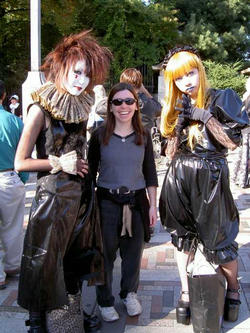| Tuesday, May 13, 2003 |
| Japanese customs |
 Japan seems such a weirdly interesting place in terms of how ancient tradition meets with the latest trends. I've never been there. But it seems like both a super conservative place where there are rigid social norms for how one behaves, and at the same time a fast moving and liberal society in other ways, with intriguing sub-cultures. Here's an article, or speech really, by some kind of anthropologist from a couple of years ago, about Japanese norms and trends. Here are some excerpts: Japan seems such a weirdly interesting place in terms of how ancient tradition meets with the latest trends. I've never been there. But it seems like both a super conservative place where there are rigid social norms for how one behaves, and at the same time a fast moving and liberal society in other ways, with intriguing sub-cultures. Here's an article, or speech really, by some kind of anthropologist from a couple of years ago, about Japanese norms and trends. Here are some excerpts:"Have you heard the word Chapatsu? It literally means 'brown hair'. These days, however, the word applies not only to brown-dyed hair but also to hair that has been dyed red, gold, or white. Chapatsu has been fashionable since around the early 1990s. Chapatsu people can be found all over Japan. In Japanese, this phenomenon is called 'heia karaa fuashon'. It is practiced by both males and females, young and old alike. For example, there are even chapatsu civil servants in their 30s or 40s.Then various stuff about the Ganguro girls, who darken their skin and wear white makeup and that kind of thing. And then this interesting thing of the Japanese customs in regards to nakedness: Now, let’s briefly look back to the body image and consciousness that Japanese people have held in modern times. The fact that most Japanese lived semi-naked up to the early years of the Meiji Era was something reported by many western people who went to Japan at this time. As the critical eyes of Westerners were feared by the Meiji government, going about the streets exposed was forbidden by law from as early as 1871 (the 4th year of the Meiji Era). But the common people felt no shame at exposing their bodies and, in fact, most peasants, fishermen and artisans lived in such a semi-naked state for more than six months every year. [ Culture | 2003-05-13 15:45 | 5 comments | PermaLink ] More > |
| Windows OS traps politician in limo, rescued by sledgehammer |
Via BoingBoing. I had already noticed that news item about the guy being trapped by a crashed computer, but now that I hear that it was running Windows, I can't help posting it.Thailand's Finance Minister Suchart Jaovisidha had to be rescued today from inside his expensive BMW limousine after the onboard computer crashed, leaving the vehicle immobilized.Somehow that just makes me feel very good. I don't know how anybody can be so crazy as to drive a car that depends on Windows to run. And even to start it and steer it, mind you. [ Information | 2003-05-13 16:03 | 5 comments | PermaLink ] More > |
| Signs of Life |
 For a while I figured I would change my business card to read something like this: For a while I figured I would change my business card to read something like this:
Looking for signs of life Well, in part because I tend to put cool but puzzling titles and bylines on my business card. Puzzling because some people (practical people) have a hard time figuring out how I possibly could make any kind of a living on that. Right now my business card says "Connecting the people who change the world". I don't know if that's something I do, but it sounds like a good thing. And, yes, nobody's paying me for doing that. So, as to the 'signs of life'. Well, most things I'm interested in concern making life more full and interesting. More life. And I'm interested in understanding better how life works. What is life? Is the universe alive? I think so, but I'd like to understand it better. You can also say I'm looking for the signal. In most any kind of communication, the information is found in those parts that stand out from the background. If I say: 0000000000000000000000000100000000000000then the information is found in the different part. The 1 in this case. That's the signal. Likewise in life. If you're just doing the same thing as everybody else, you're not providing any signal. You're not showing signs of being alive. You're wasting God's time, if you want to put it that way. I'm interested in the stuff that's different and alive with energy. The people who start a green hair culture when everybody else thinks one has to have black hair. The people who think up something entirely different that actually works. The people who feel a different beat and who actually dance to it. I'm interested in patterns that hadn't been noticed before. And the meeting of different patterns. Life is diverse. There's something free about life, so I'm looking for freedom. People who manage to tap into something fundamental, but yet express it in ways that aren't restrained by old patterns of thinking or unnecessary norms for behavior. Changing the rules. Exploring your range of motion. And then I'm interested in how it all fits together. Ecosystems are diverse and synergetic. Diversity is life. Monoculture is death. But it is not that simple. It is not enough to just make things different. It is not enough to just break the rules. The magic is in the synergy. How different things work together, and support each other, in sometimes surprising ways. Finding patterns that make diversity work. Self-regenerating systems that thrive on diversified experimentation. Autopoiesis. Self-creation. Life. I'm looking for small signs, and I'm looking for some bigger signs. Signs that humanity is alive and becoming more alive. [ Thoughts | 2003-05-13 17:17 | 2 comments | PermaLink ] More > |